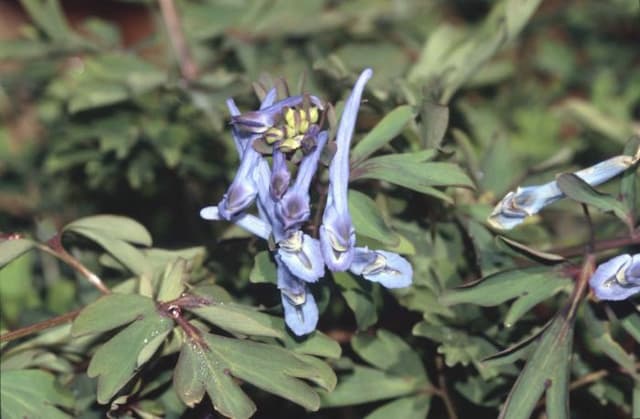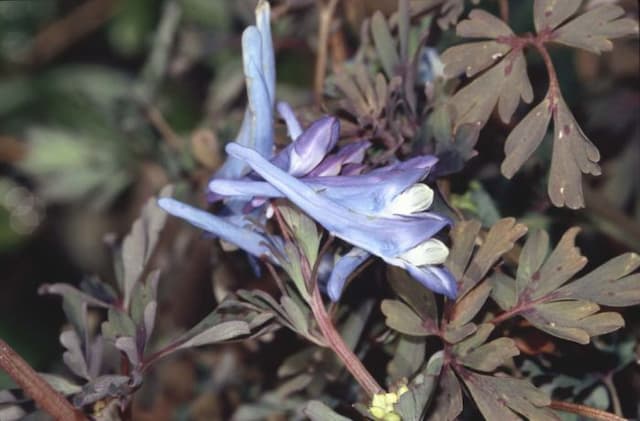Malkensis Corydalis Corydalis malkensis

ABOUT
Corydalis malkensis is a flowering plant known for its distinct features that add a touch of elegance to garden environments. This plant is characterized by delicate, fern-like foliage that creates a soft and airy texture. The leaves are often green, providing a rich backdrop for the blossoms. It produces charming flowers which are typically tubular and have a spur at the rear; these blooms can be found in an array of colors depending on the variety, including shades of yellow, pink, or purple. The flowers are arranged in racemes, meaning they form a cluster along the stem, presenting a graceful display that resembles a gentle cascade. These racemes make the plant particularly attractive during its blooming season. The overall visual effect of Corydalis malkensis is one of dainty elegance, with a combination of its feathery foliage and the picturesque arrangement of its colorful flowers.
About this plant
 Names
NamesFamily
Papaveraceae
Synonyms
Malkensis Fumewort
Common names
Corydalis malkensis.
 Toxicity
ToxicityTo humans
Corydalis malkensis, commonly known as Corydalis, has compounds that can be toxic if ingested. The plant contains alkaloids such as corydaline and acetylcorynoline, which can affect the central nervous system. If ingested, symptoms may include nausea, vomiting, dizziness, and fatigue. In severe cases, it can lead to respiratory depression and cardiac complications. Avoid eating any part of this plant.
To pets
Corydalis malkensis, commonly known as Corydalis, can be toxic to pets if ingested. The plant contains various alkaloids that may harm animals, potentially leading to symptoms such as gastrointestinal upset, with possible signs of drooling, vomiting, and diarrhea, as well as nervous system effects like tremors or seizures in severe cases. It is essential to prevent pets from consuming any part of this plant to avoid such toxic effects.
 Characteristics
CharacteristicsLife cycle
Perennials
Foliage type
Deciduous
Color of leaves
Green
Flower color
Varies
Height
8 inches (20 centimeters)
Spread
12 inches (30 centimeters)
Plant type
Herb
Hardiness zones
5
Native area
Asia
Benefits
 General Benefits
General Benefits- Aesthetic Appeal: Adds visual interest to gardens with its delicate foliage and flowers.
- Pollinator Support: Attracts bees and other pollinators, supporting local ecosystems.
- Low Maintenance: Requires minimal care once established, making it an easy addition for gardeners.
- Shade Tolerance: Thrives in shaded areas where other plants may struggle to grow.
- Erosion Control: Helps stabilize soil in gardens or on slopes with its root structure.
- Seasonal Interest: Produces colorful blooms that can enhance the seasonal variety in a garden setting.
- Diversity: Contributes to biodiversity by providing habitat and food for various insects.
- Companion Planting: Can be used alongside other plants to create aesthetically pleasing and ecologically balanced garden designs.
 Medical Properties
Medical PropertiesThis plant is not used for medical purposes.
 Air-purifying Qualities
Air-purifying QualitiesThis plant is not specifically known for air purifying qualities.
 Other Uses
Other Uses- Corydalis malkensis can be used as a natural dye for fabrics, imparting a yellowish color when the roots are processed.
- In specialized gardens, this plant can serve as a marker for the arrival of spring, as it is one of the early bloomers in temperate climates.
- The plant may be used in educational settings for botany students to study the unique bulbous growth and flowering patterns of the Fumariaceae family.
- The crushed foliage of Corydalis malkensis could potentially be used as a natural insect repellent, although its effectiveness and safety would need to be confirmed.
- Gardeners may plant Corydalis malkensis as a cover for fading bulb foliage from early spring flowers, as its foliage can remain attractive after blooming.
- The seed capsules of Corydalis malkensis open explosively, which can be used to demonstrate seed dispersal mechanisms to students or nature enthusiasts.
- Corydalis malkensis, with its delicate appearance, is often used in photography and botanical illustrations to highlight the intricate beauty of alpine plant species.
- Flower arrangers could use Corydalis malkensis as a delicate addition to floral compositions, particularly in small, elegant arrangements.
- This plant can be used as a biological indicator of soil pH and type since it prefers a specific kind of substrate to grow, thus aiding in ecological studies.
- The roots of Corydalis malkensis can be studied for their adaptation to cold environments, potentially contributing to research in plant resilience and survival.
Interesting Facts
 Feng Shui
Feng ShuiThe Corydalis plant is not used in Feng Shui practice.
 Zodiac Sign Compitability
Zodiac Sign CompitabilityThe Corydalis plant is not used in astrology practice.
 Plant Symbolism
Plant Symbolism- Hope: Corydalis, with its resilient nature and ability to bloom in harsh conditions, often represents hope in the face of adversity.
- New Beginnings: The blooming of the Corydalis flower, particularly in spring, signifies new beginnings and the cycle of life.
- Tranquility: The soft, delicate appearance of Corydalis flowers can symbolize tranquility and peace.
- Love: In some traditions, the Corydalis plant is a symbol of love and affection, particularly because of its attractive and delicate flowers.
 Water
WaterCorydalis malkensis, commonly known as Fumewort, requires moist but well-drained soil, mimicking its natural woodland habitat. Water the plant deeply when the top inch of soil feels dry to the touch, which may roughly translate to once a week depending on the environmental conditions. Each watering session should provide enough water to moisten the soil thoroughly, which could be approximately 1-2 gallons for a mature plant, depending on the size and the pot. During the growing season in spring and summer, you might need to water more frequently, whereas in winter, you can reduce watering as the plant goes dormant.
 Light
LightFumewort thrives best in partial shade, replicating its native environment under woodland canopies. The ideal spot for the plant is in dappled sunlight, where it receives bright indirect light without the harshness of direct afternoon sun. Morning sunlight with afternoon shade or a spot that gets filtered light throughout the day is optimal. Overexposure to strong sunlight can lead to leaf scorch, while too much shade might reduce flowering.
 Temperature
TemperatureFumewort best grows in cool to moderate temperatures, ideally between 50°F and 75°F. It can withstand minimum temperatures down to around 32°F, making it somewhat frost-tolerant. However, it may not survive extreme heat, particularly temperatures consistently above 80°F. The best ambient temperature conditions for this plant would be a cool environment that doesn't fluctuate into extremes of hot or cold.
 Pruning
PruningPruning Fumewort isn't strictly necessary but can be useful for aesthetic reasons or to remove spent flowers and dead foliage. Pruning can be done after the plant has flowered in early summer to tidy up the plant and encourage a second flush of blooms. Cut back the foliage to within a few inches of the ground after flowering or when the leaves start to yellow. Deadheading regularly during the flowering season can also promote more blooms.
 Cleaning
CleaningAs needed
 Soil
SoilCorydalis malkensis, commonly known as Corydalis, thrives in a well-draining, moisture-retentive soil mix with a pH range of 6.0 to 7.5. A mix of two parts garden soil, one part peat or coir, and one part sharp sand or perlite is recommended for optimal growth.
 Repotting
RepottingCorydalis should be repotted every 2 to 3 years to refresh the soil and to accommodate its growing root system. The best time to repot is in the spring, just as the plant begins to show new growth.
 Humidity & Misting
Humidity & MistingCorydalis prefers a moderately humid environment. Ideally, the humidity level should be between 45% and 65% for optimal growth. Avoid placing the plant in overly dry conditions as it can stress the plant.
 Suitable locations
Suitable locationsIndoor
Place Corydalis in bright, indirect light and ensure good air circulation.
Outdoor
Plant in partial shade; keep soil moist but well-drained.
Hardiness zone
5-8 USDA
 Life cycle
Life cycleCorydalis malkensis, commonly known as Malkensis Fumewort, begins its life as a seed that typically requires a period of cold stratification to break dormancy. Upon germination, a radicle emerges and develops into a small root system, while cotyledons provide initial nutrients as the first true leaves develop. As a perennial herb, it enters a vegetative stage where foliage expands and the plant establishes itself, thriving in shady, well-drained locations. After reaching maturity, Malkensis Fumewort produces delicate, tube-shaped flowers, typically in spring, which are pollinated by insects, leading to the formation of fruit capsules containing numerous small seeds. These seeds are dispersed by various means such as wind, water, or animal movement, completing the reproductive phase. The plant then enters a period of dormancy, particularly in colder climates, with above-ground parts dying back and underground tubers or rhizomes surviving through the winter to sprout again during the next growing season.
 Propogation
PropogationPropogation time
Spring to early summer
Corydalis malkensis, commonly known as fumewort, is often propagated through seed since it can be difficult to divide due to its delicate tuberous roots. The optimal time for sowing seeds is in the fall, allowing them to undergo a natural stratification process over the winter months, which helps to break seed dormancy and promotes germination in the spring. To propagate fumewort by seed, selection of a well-draining soil mix is crucial. The seeds are thinly scattered over the soil surface and then lightly covered with soil or fine grit. The container should be watered gently to avoid disturbing the seeds and placed in a cold frame or another protected outdoor area. Seeds require patience as they may take several months to germinate. Once seedlings emerge and are large enough to handle, they can be individually potted and gradually acclimated to outdoor conditions before planting in their final location.









